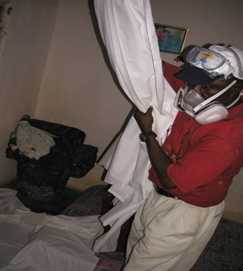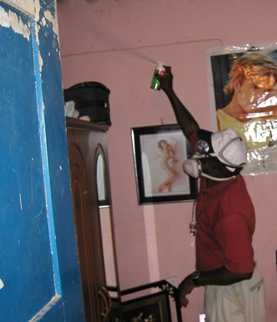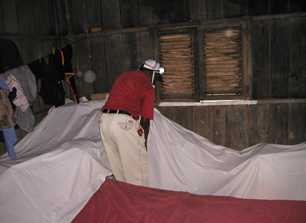Standard Operating Procedure for collecting resting mosquitoes with pyrethrum spray catch
Tanya L L Russell, Kyran Staunton, Thomas R Burkot
Disclaimer
This Standard Operating Procedure may be used for training and reference purposes. Users are responsible for ensuring any edits to this document are produced and approved in accordance with all relevant legal and ethical requirements governing the surveillance operation.
Abstract
The purpose of this SOP is to outline the materials and processes required to perform pyrethrum spray catches (PSCs) inside rooms or houses to collect indoor resting mosquitoes.PSCs are commonly called knockdown spray catches.
Description: Pyrethrum spray catches is a standard method of catching mosquitoes resting inside houses and animal shelters. It is usually an efficient method, but its efficacy depends on the house construction. Briefly, it involves spraying the interior of the structure with an adulticide to knock down any resting mosquitoes. The mosquitoes are then collected of white sheets placed on the ground.
Target species and physiological states: Captures resting adults of both sexes and many species.
Entomological surveillance indicators: Adult vector occurrence, density and resting location.
Advantage: Pyrethrum spray catches are cheap and relatively simple to perform.
Disadvantage: Pyrethrum spray catches are labour intensive and require trained staff and while make it efficient to capture resting mosquitoes, specific information on where the mosquitoes are resting (how high on a wall) are not available from this technique. This technique may not work for Aedes species resting under furniture covered by collection sheets.
Sampling period: Collections should take during period of minimum flight activity. For Anopheles mosquitoes, preferably in the early morning.
Data: Total number of resting mosquitoes per sampling effort (by species and sex).
Attachments
Steps
Sampling procedure
Gather all equipment.
A pyrethrum spray containing pyrethroid containing piperonyl butoxide (PBO) is preferred but permethin in a pump sprayer can also be used.
Identify the homes where the PSC will be conducted. Notify the head of the household and receive permission, ideally the day before collections.
The best houses for PSC are either a house with 1 room, or a larger house that has separated sealed rooms. If such houses aren’t available (e.g. houses have several rooms that are connected by open eaves), conduct PSC in all the rooms.
Inform the head of household a day before the spray to avoid doing anything that will repel mosquitoes on the night before collection, such as smoking inside the house, using repellents or spraying aerosol insecticides
Pyrethrum spray catch should be conducted early in the morning at approximately 05:00 to 08:00. At least two technicians are required to sample each household.
Prepare the house, early in the morning.
a.All occupants and animals must remain outside
b.Remove all easily movable objects such as small tables and chairs, exposed food and drinking water. Cover any water pots that cannot be moved.
c.Use sacking material to cover any openings that cannot be sealed (e.g. eaves or windows).
d.Spread white sheets (calico or strong fabric) over the entire floor, over the bed and over furniture and miscellaneous objects that have not been removed.
e. Close all windows and doors.

Spray the surfaces that mosquitoes may be resting on, including the walls and ceiling.
When spraying the aerosol, the technician should wear appropriate personal protective equipment (PPE), including a respirator mask and goggles.
If the house has open eaves, use two technicians to spray first from the outside and immediately thereafter from inside the house. The person outside should spray through any openings such as eaves and windows, with the person inside simultaneously spraying towards the ceiling until the room is filled with a fine mist.

After all rooms are sprayed the operator leaves the house quickly and makes sure that the door remains closed for 10 minutes while waiting for the mosquitoes to be knocked down.
To collect the mosquitoes, open the door. Starting from the doorway, pick up the sheets one at a time by the corners, so that all insects slide to the center of the sheet. Tip the mosquitoes onto a single sheet. Mosquitoes can be collected from the spray sheets while they remain in position on the floor.

Temporarily store the mosquitoes in labelled collection cups until processing and long-term storage.
For details on processing and storage see Tanya Russell, Kyran Staunton, Amanda Murphy, Thomas Burkot 2022. Standard operating procedures for mosquito vector surveillance, processing and storage. protocols.io https://dx.doi.org/10.17504/protocols.io.eq2lyn13qvx9/v3
Replace all furniture and objects back in the house.
Additional notes
Sheets must be washed regularly, because mosquitoes are easily overlooked when collecting from dirty sheets.
It is more difficult to efficiently spray very large huts, especially those that are divided into a number of rooms, and also those that have high roofs.


